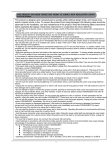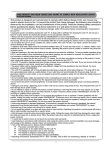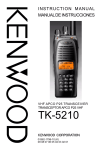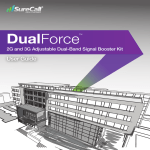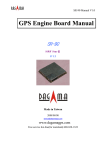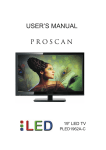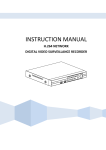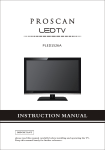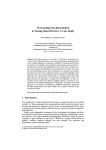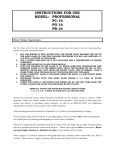Download Welcome to use
Transcript
THIS PRODUCT HAS BEEN TESTED AND FOUND TO COMPLY WITH REGULATORY SAFETY CERTIFICATIONS. This product is designed and manufactured to operate within defined design limits, and misuse may result in electric shock or fire. To prevent the product from being damaged, the following rules should be observed for the installation, use and maintenance of the product. Read the following safety instructions before operating the display. Keep these instructions in a safe place for future reference. • To avoid the risk of electric shock or component damage, switch off the power before connecting other components to the LCD TV. • Unplug the power cord before cleaning the LCD TV. A damp cloth is sufficient for cleaning the LCD TV. Do not use a liquid or a spray cleaner for cleaning the product. Do not use abrasive cleaners. • Always use the accessories recommended by VQ to insure compatibility. • When moving the LCD TV from an area of low temperature to an area of high temperature, condensation may form on the housing. Do not turn on the LCD TV immediately after this to avoid causing fire, electric shock or component damage. • Do not place the LCD TV on an unstable cart, stand, or table. If the LCD TV falls, it can injure a person and cause serious damage to the appliance. • A distance of at least 3 feet should be maintained between the LCD TV and any heat source, i.e. radiator, heater, oven, amplifier etc. Do not install the product close to smoke. Operating the product close to smoke or moisture may cause fire or electric shock. • Slots and openings in the back and bottom of the cabinet are provided for ventilation. To ensure reliable operation of the LCD TV and to protect it from overheating, be sure these openings are not blocked or covered. Do not place the LCD TV in a bookcase or cabinet unless proper ventilation is provided. • Never push any object into the slot on the LCD TV cabinet. Do not place any objects on the top of the product. It could short circuit parts causing a fire or electric shock. Never spill liquids on the LCD TV. • The LCD TV should be operated only from the type of power source indicated on the label. If you are not sure of the type of power supplied to your home, consult your local power company. • The power cable must be replaced when using different voltage from that specified in the User Manual. For more information, contact VQ. • The LCD TV is equipped with a three-pronged grounded plug, a plug with a third (grounding) pin. This plug will fit only into a grounded power outlet as a safety feature. If your outlet does not accommodate the three-wire plug, have an electrician install the correct outlet, or use an adapter to ground the appliance safely. Do not defeat the safety purpose of the grounded plug. • Do not overload power strips and extension cords. Overloading can result in fire or electric shock. • The wall socket should be installed near the equipment and should be easily accessible. • Do not touch the power cord during lightning. To avoid electric shock, avoid handling the power cord during electrical storms. • Unplug the unit during a lightening storm or when it will not be used for long period of time. This will protect the LCD TV from damage due to power surges. • Do not attempt to repair or service the product yourself. Opening or removing the back cover may expose you to high voltages, the risk of electric shock, and other hazards. If repair is required, please contact VQ and refer all servicing to qualified service personnel. • Keep the product away from moisture. Do not expose this appliance to rain or moisture. If water penetrates into the product, unplug the power cord and contact VQ. Continuous use in this case may result in fire or electric shock. • Do not use the product if any abnormality occurs. If any smoke or odor becomes apparent, unplug the power cord and contact VQ immediately. Do not try to repair the product yourself. • Avoid using dropped or damaged appliances. If the product is dropped and the housing is damaged, the internal components may function abnormally. Unplug the power cord immediately and contact VQ for repair. Continued use of the product may cause fire or electric shock. • Do not install the product in an area with heavy dust or high humidity. Operating the product in environments with heavy dust or high humidity may cause fire or electric shock. • Hold the power connector when removing the power cable. Pulling the power cable itself may damage the wires inside the cable and cause fire or electric shock. When the product will not be used for an extended period of time, unplug the power connector. • To avoid risk of electric shock, do not touch the connector with wet hands. • Insert batteries in accordance with instructions while using the remote control. Incorrect polarities may cause damage and leakage of the batteries, operator injury and contamination of the remote control. • If any of the following occurs, please contact VQ: The power connector fails or frays. Liquid sprays or any object drops into the LCD TV. The Display is exposed to rain or other moisture. The Display is dropped or damaged in any way. The performance of the Display changes substantially. • Operating environment: Temperature: 40°F ~ 95°F, Humidity: 10% to 90% non-condensing, Altitude: 0~10,000 ft. 1 Note: In some countries or regions, the shape of the power plug and power outlet may sometimes differ from that shown in the explanatory drawings. However, the method of connecting and operating the unit is the same. Television Antenna Connection Protection External Television Antenna Grounding If an outside antenna/satellite or cable system is to be connected to the LCD TV, make sure that theantenna/satellite or cable system is electrically grounded to provide some protection against voltage surges and static charges. Article 810 of the National electrical Code, ANSI/NFPSA 70, provides information with regard to proper grounding of the mast and supporting structure, grounding of the lead-in wire to an antenna discharge unit, size of the grounding conductors, location of antenna discharge unit, connection to grounding electrodes, and requirements of the grounding electrode. GROUND CLAMP ANTENNA LEAD-IN WIRE ANTENNA DISCHARGE UNIT (NeC SeCTION 810-20) GROUNDING CONDUCTORS (NeC SeCTION 810-21) GROUND CLAMPS POWER SERVICE GROUNDINE ELECTRODE SYSTEM ELECTRIC SERVICE EQUIPMENT (NeC ART 250, PART H) Lightning Protection For added protection of your LCD TV during a lightning storm or when it is left unattended or unused for long periods of time, unplug the LCD TV from the wall outlet and disconnect the antenna/satellite or cable system. Power Lines Do not locate the antenna near overhead light or power circuits, or where it could fall into such power lines or circuits. 2 Opening the Package Your VQ HDTV is packaged in a carton together with other standard accessories. Any optional accessories would be packed separately in another carton. The weight of the LCD display is approximately 4 lbs. Due to the size and weight of the product, it is suggested that it be handled by a minimum of 2 persons. Since the glass can be easily scratched or broken, please handle the product gently. Never place the unit on a surface with the glass facing downwards unless it is on protective padding. When opening the carton, check that the product is in good condition and that all standard accessories and items are included. IMPORTANT: Save the original box and all the packing material for future shipping needs. Package Contents VQ HDTV Remote Control Audio Video Cable (yellow, red and white connectors) Power Cord This User guide Quick Setup guide Registration Card Batteries 3 Additional VQ Certified Accessories for the VQ HDTV are sold separately: Wall Mounts High Definition Cables Extra or replacement Remote Installation Preparation Please read the user manual carefully before performing the installation. The power consumption of the display is approximately 60 watts, please use the power cord designated for the product. When an extension cord is required, use one with the correct power rating. The cord must be grounded and the grounding feature must not be defeated. The product should be installed on a flat surface to avoid tipping. Space should be maintained between the back of the product and the wall for proper ventilation. If you would like to mount the TV to the wall, please see “Preparing the LCD for Wall Mounting” below for additional information. Avoid installing the product in the kitchen, bathroom or other places with high humidity, dust or smoke, so as not to shorten the service life of the electronic components. Please ensure the product is installed with the screen in landscape orientation. Any 90° clockwise or counterclockwise installation may induce poor ventilation and excessive component damage. 4 CONTENTS 1. Connecting Equipment......................................................................6 2. Descriptions of Main Unit and Remote-Control Unit.................................14 2.1 Main Unit..................................................................................................14 2.2 Front Panel Control ................................................................................ 14 2.3 Remote-Control Unit...............................................................................15 2.4 Illustration of the Interface Panel..........................................................18 3. Connection and Preparation........................................................................19 3.1 Connect Antenna or Video Facility........................................................19 3.2 Battery Installation of Remote-Control Unit....................................19 4. The OSD Menus........................................ .....................................20 4.1 OSD Adjustment in ATV mode……….…………............................20 4.2 DVD OPERATION…………………………………………..……………….25 5. PC display mode.............................................................................................27 6. Trouble Shooting.....................……………….............................................28 7. Specifications............................................................................................29 5 1. Connecting Equipment 1.1 - Which Video Connection Should I Use? This HDTV has six different ways to connect your video equipment from a basic connection to the most advanced for digital displays. Connection Quality (type) Connector Description Digital HD (HDMI - High-Definition Multimedia Interface) - It is the first and only industry-supported, uncompressed, all-digital audio/video interface. HDMI provides an interface between any audio/video source, such as a set-top box, DVD player, or A/V receiver and an audio and/or video monitor, such as a digital television (DTV), over a single cable. DTV Coaxial RF. When used for MPEG2 encoded bit streams from ATSC broadcast programming, this input takes advantage of the High Definition content. best (digital) best (digital) Left Analog RGB (VgA) - This video input has seperate red, green and blue color components. The signal carries horizontal and vertical sync information on the green signal. This is most commonly used for PC input Analog HD1/HD2 (Component) - The video signal is separated into three signals, one containing the black-and-white information and the other two containing the color information. This enhancement over S-Video takes advantage of the superior picture provided by progressive scan DVD players and HDTV formats. S-Video (AV ) - The video signal is separated into two signals, one containing the black-and-white information and the other containing the color information. Separating the color in this way avoids ‘cross color’ effects where closely spaced black and white lines are erroneously displayed in color. It also enables text to be displayed more sharply. AV1/AV2/AV (Composite) - The complete video signal is carried through a single pin connector. This is the most commonly used video connection. best (analog) better (analog) good (analog) good (analog) TV Coaxial RF. This is the connection for standard NTSC TV using antenna or cable. If you have a VCR, you can connect your antenna/cable to the VCR RF Input and connect the VCR RF Output to this connector. good (analog) Right 6 1.2 - Connecting Your DVD Player you have several options for connecting your DVD player to your new VQ HDTV – HDMI (Digital HD), Component (Analog HD), S-Video (AV), and Composite (AV) inputs. Based on your home theater configuration, you can decide which option is the right one for you. 1.2.1 - Using HDMI (Digital HD) DVD players that have a digital interface such as HDMI (High-Definition Multimedia Interface) should be connected to the HDMI input of the HDTV for optimal results. Connecting DVD Player (Best): 1. Turn off the power to the LCD TV and DVD player. 2. Connect a HDMI cable to the HDMI output of your DVD player and the other end to the HDMI input (white color area) in the rear of your LCD TV. 3. Turn on the power to the LCD TV and your DVD player. 4. Select Digital HD using the INPUT button on the front of the LCD TV or directly by pressing the INPUT button on the Remote Control. Note: Refer to your DVD player user manual for more information about the video output requirements of the product. 7 For DVD Players with DVI: 1. Turn off the power to the LCD TV and DVD player. 2. Using a HDMI-DVI cable, connect the DVI end to your DVD Player and the HDMI end to the HDMI input (located in the white area) in the rear of your LCD TV. 3. Using an audio cable (white and red connectors), connect cable to the audio output connecters associated with the DVI output on the rear of your DVD Player, and connect the other end to the audio connectors (white area) associated with the HDMI input in the rear of your LCD TV. 4. Turn on the power to the LCD TV and your DVD Player. 5. Select digital HD using the input button on the front of the LCD TV or directly by pressing the INTPUT button on the remote control. 8 1.2.2 - Using Component (Analog HD1) Video Connecting DVD Player (Better): 1. Turn off the power to the LCD TV and DVD player. 2. Using the connectors in the green color area, connect the y (green color) connector on the rear of your DVD player to the corresponding y (green color) connector in the Component Analog HD1 group (green color band) in the rear of your LCD TV. 3. Connect the Pb (blue color) connector on the rear of your DVD player to the corresponding Pb (blue color) connector in Component Analog HD1 group (green color band) in the rear of your LCD TV. 4. Connect the Pr (red color) connector on the rear of your DVD player to the corresponding Pr (red color) connector in the Component Analog HD1 group (green color band) in the rear of your LCD TV. 5. Connect the R (red color) and L (white color) audio connectors on the rear of your DVD player to the R (red color) and L (white color) audio input connectors in the Component Analog HD1 group (green color band) in the rear of your LCD TV. 6. Turn on the power to the LCD TV and DVD player. 7. Select Component Analog HD1 using the INPUT button on the remote or front of the LCD TV or directly by pressing the INPUT button on the Remote Control. Note: a) If you are already using the Component Analog HD1 input for another component, or you do not want to use the Component Analog HD1 input for the DVD player, you can connect the DVD player to the Component Analog HD2 connections coded by the blue color area. b) Refer to your DVD player user manual for more information about the video output requirements of the product. 9 1.2.3 - Using Composite (AV) Video Connecting DVD Player (Good): 1. Turn off the power to the LCD TV and DVD player. 2. Connect the S-Video jack on the rear of your DVD player to the S-Video jack in the AV In group on the side of your LCD TV. 3. Connect the R (red color) and L (white color) audio connectors on the rear of your DVD player to the R (red color) and L (white color) audio input connectors in the side of your LCD TV. 4. Turn on the power to the LCD TV and DVD player. 5. Select AV using the INPUT button on the remote or front of the LCD TV or directly by pressing the AV button on the Remote Control three times. Note: Refer to your DVD player user manual for more information about the video output requirements of the product. 10 1.4 - Connecting Coaxial (RF) There are several options for connecting your antenna (or cable for TV) to your new HDTV directly to the DTV, NTSC TV or through your VCR. Based on your home theater configuration, you can decide which option is the right one for you. 2.5.1 - Using Your Antenna or Digital cable for DTV 1. Turn off the power to your LCD TV. 2. Connect the coaxial (RF) connector from your Antenna or Digital Cable to the DTV connector on the rear of your LCD TV. 3. Turn on the power to your LCD TV. 4. Select DTV using the INPUT button on the front of your LCD TV or directly by pressing the Digital HD button on the Remote Control twice. Note: a) Digital broadcasts are not available in all areas. detailed information. b) Make sure the antenna is correctly grounded. 11 Refer to www.antennaweb.org for 1.5.2 - Using Your Antenna or Cable TV 1. Turn off the power to your LCD TV. 2. Connect the coaxial (RF) connector from your antenna, cable or cable box to the TV connector on the rear of your LCD TV. 3. Turn on the power to your LCD TV. 4. Select TV using the INPUT button on the front of your LCD TV or directly by pressing the NTSC TV button on the Remote Control. 2.5.3 - Using the Antenna or Cable through Your VCR Note: If you have an off-air antenna or cable TV, connect the off-air antenna or TV cable to the RF connector on the rear of your VCR. 12 1.6 - Connecting a Computer 1. Turn off the power to your LCD TV and Computer. 2. Connect a 15-pin D-sub RGB (VGA) cable to the Rgb output of your computer and the other end to the RGB input (purple area) in the rear of your LCD TV. 3. Connect the Audio Out on your computer to the RGB Audio (purple band) at the rear of your LCD TV. 4. Turn on the power to your LCD TV and computer. 5. Select RGB using the INPUT button on the front of your LCD TV or directly by pressing the RGB button on the Remote Control. Note: a) For the best picture quality when connecting a computer through RGB, set your computer timing mode to VESA 1366 x 768 at 60 Hz or 1024 x 768 at 60 Hz. Please refer to the graphic card’s user guide for additional information on how to set the timing mode. b) Refer to your computer user manual for more information about the video output requirements of the product. c) A Stereo mini jack cable is not included and can be purchased at an electronic store. 13 2. Descriptions of Main Unit and Remote-Control Unit 2.1 Main Unit 2.2 Front Panel Control 2.2.1. VOL -/+: Press to turn down /up the volume. 2.2.2. CH-/+: Press to scan through channels. 2.2.3. Menu: Menu display. 2.2.4. INPUT: Press to switch the input source mode. 2.2.5. Power: Press to turn on and off the TV. 2.2.6. ►▎:Press to play and pause DVD. 2.2.7. : Press to open and close DVD. 14 2.3 Remote-Control Unit 15 2.3.1.TV Remote User’s Manual 1.POWER Press to turn TV on and off 2. MUTE Press this button to mute or restore sound 3. 0~9 Use to enter TV channel numbers 4. RETURN Switch between the current TV channel and the last 5. Under TV to 10 frequency channels above frequency channel 6. CH-/CH+ Change channels one at a time in descending or ascending order 7.VOL-/VOL+ Increase or decrease the TV volume 8. INPUT Use to select the input source of the TV Press this button to enter the menu screens for various optional adjustable settings 9. MENU 10.ENTER Press this key to confirm selection of an item 11. ▲ Menu up 12.▼ Menu down 13.◄ Menu left 14.► Menu right 15.EXIT Press this button to exit all menu 16.MTS Toggle between Stereo and Mono sound 17.ZOOM Use to change the zoom setting of the picture 18.DISPLAY Toggle current display information 19.CC Toggle closed captioning settings 20.P MODE Press this button to select the desired picture mode 21.S MODE Press this button to select the desired sound mode 22.SLEEP Press to set automatic sleep timer 23.EPG Use to display Electronic Programming Guide - where available 24. FAV Display list of favorite television programs 25.FAV+ Favorite television programs up 26.FAV- Favorite television programs down 16 2.3.2.DVD Player User’s Manual 2.OK Brings up the DVD player’s Setup Menu. Use “UP”, “DOWN”, “LEFT”, “RIGHT” to select setup item, and use “ENTER” to affirm then execute Press this button to confirm adjusted item 3. ▲(DIGIT 2) DVD Menu up 4.▼(DIGIT 8) DVD Menu down 5.◄(DIGIT 4) DVD Menu left 6.►(DIGIT 6) DVD Menu right 7. open/close Press to open and close the disc tray 8.PLAY Press to start the playback of a DVD 9.PAUSE Press to pause the DVD 10.STOP Stops disc play 11.REV Toggle Rewind speed 12.FWD 13.PREV 14.NEXT Toggle fast forward speed Skip to the previous track/title/chapter Skip to the next track/title/chapter 1.DVD SETUP 17 2.4 Illustration of the Interface Panel 1. Back panel connections . Component Input 1 2 3 4 5 6 7 DC IN HDMI input VGA input Y Pb Pr S-VIDEO input 8 9 10 11 12 13 18 CVBS input CVBS & S-Video Left Audio Input CVBS & S-Video Right Audio Input PC Audio Input Audio Earphone Output TV signal Input 3. Connections and Preparation 3.1 Connect Antenna or Video Facility 1. Use 75Ω coaxial cable plug or 300-75Ω impedance converter to plug in antenna input terminal on the rear of the cabinet. 2. Connect the video facility to the audio, video in jack on the rear of the cabinet. 3.2 Battery Installation of Remote-Control Unit 1. Turn the remote-control unit upside down. Scratch the grip of the battery compartment 2. Install two new 1.5V AAA batteries, make sure the anode and cathode of the batteries matches the “+”, “–” marks inside the battery compartment. Or not it would damage the unit. 3. Close the battery compartment cover. 19 4. The OSD Menus 4.1. OSD Adjustment in ATV mode VIDEO menu options Press the MENU button on the front panel or on the remote control to display the main menu. 1. 2. 3. 4. Press ▼ / ▲ button to select PICTURE in the main menu,and press ►or menu button into the PICTURE. Press ▼ / ▲ button to select the option that you want to adjust in the PICTURE menu. Press ◄ / ► button to adjust When you are satisfied with your adjustment, press the MENU button to return to the previous menu or press the EXIT button to exit the main menu. Picture Mode Select Picture Mode in PICTURE menu. (Available picture mode: normal, user, soft, vivd.)If you change the value of Brightness, Contrast , saturation, Sharpness ,HUE or scale on the picture menu.You may select the picture mode directly by pressing PMODE button. Brightness Press ▼ / ▲ button and then use ◄ / ► to adjust the brightness of the picture. Contrast Press ▼ / ▲ button and then use ◄ / ► to adjust the contrast of the picture. Saturation Press ▼ / ▲ button and then use ◄ / ► to adjust the color saturation. sharpness Press ▼ / ▲ button and then use ◄ / ► to adjust the Sharpness. HUE Press ▼ / ▲ button and then use ◄ / ► to adjust the brightness of the picture. 20 SOUND menu options Press the MENU button on the front panel or on the remote control to display the main menu. 1. 2. 3. 4. 5. Press the ▼ / ▲ button to select SOUND in the main menu. and press ►or menu button into the SOUND. Press the ▼ / ▲ button to select the option that you want to adjust in the SOUND menu press ►or menu button to choose. Press the ◄ / ► button to adjust When you are satisfied with your adjustment, press the MENU button to return to the previous menu or press the EXIT button to exit the main menu. Sound Mode Select Sound Mode in SOUND menu. (Available sound mode: Normal,User,Movie and News.) You may select the sound mode directly by pressing SMODE button. Volume Press ▼ / ▲ button and then use ◄ / ► to adjust the sound level. Bass Press ▼ / ▲ button and then use ◄ / ► to increase or decrease the level of the lower-pitched sounds. Treble Press ▼ / ▲ button and then use ◄ / ► to increase or decrease the level of the higher-pitched sounds. Balance Press ▼ / ▲ button and then use ◄ / ► to adjust the audio output between left and right speakers. 21 TV menu options Press the MENU button on the front panel or on the remote control to display the main menu. 1. Press the ▼ / ▲ button to select SETUP in the main menu and press ►or menu button into the Channel. 2. Press the ▼ / ▲ button to select your option what you want to adjust in the channel menu. 3. Press the ◄ / ► button to adjust. 4. When you are satisfied with your adjustment, press the MENU button to return to the previous menu or press the EXIT button to exit the main menu. Auto Tune Press ▼ / ▲ button and then use ◄ / ► to select” Auto Tune“ This option allows you to tune the channels that can be received automatically. Fine Tune Press ▼ / ▲ button and then use ◄ / ► to select and adjust” Finel Tune“ ADD/ERASE Press ▼ / ▲ button and then use ◄ / ► to select and adjust” ADD/ERASE“ SOURCE Press ▼ / ▲ button and then use ◄ / ► to select and adjust” SOURCE“ 22 Function menu options Press the MENU button on the front panel or on the remote control to display the main menu. 1. Press the ▼ / ▲ button to select FUNCTION in the main menu. and press ►or menu button into the Function. 2. Press the ▼ / ▲ button to select your option what you want to adjust in the FUNCTION menu. 3. Press the ◄ / ► button to adjust. 4. When you are satisfied with your adjustment, press the MENU button to return to the previous menu or press the EXIT button to exit the main menu. Language Press ◄ / ► to select the language of the OSD Blue Back This option allows you to select the blue background on or off. If on, the screen background will turn blue at very weak or no signal condition. C.Caption Press ▼ / ▲ button and then use ◄ / ► to select and adjust” C.Caption“ Parent CTRL Press the ◄ / ► button to select “Parent CTRL” Press ENTER or ► button to set the child lock. Initializes password is 8899. 1. Press the ▼ / ▲ button to select your option what you want to adjust in the item. 2. Press the ◄ / ► button to adjust. 3. When you are satisfied with your adjustment, press the MENU button to return to the previous menu or press the EXIT button to exit the main menu. 23 NEW PASSWORD Input password what you want . V-CHIP Press ▼ / ▲ button and then use ◄ / ► to select and adjust” V-CHIP“ TV-RATING Press ▼ / ▲ button and then use ◄ / ► to select and into “TV-RATING” as follow: Color Temp. Select an optimum color temperature mode to suit your eyes for viewing among Normal, Warm and Cold. DNR If the broadcast signal received is weak, you can select the DNR option to reduce the video noise level between Off, Low, Mid and High. Reset Press ENTER or ► button to reset the TV to the factory default. 24 4.2.DVD OPERATION Press the input button on the front panel or on the remote control to display the source menu. Press ▼ / ▲ button to select “DVD” item and press ENTER or ► button enter DVD. Press the DVD SETUP on the remote control to display the SYSTEM SETUPopertion. TV SYSTEM According to the Color System of the TV, you can choose the TV System. 1. AUTO: Choose this settings if your DVD player is connected to a multi-system TV. 2. NTSC: Choose this settings if your DVD player is connected to a NTSC TV. 3. PAL: Choose this settings if your DVD player is connected to a PAL TV. VIDEO Select VIDEO in SYSTEM SETUP menu. (Available: INTERLACE-YUV) TV TYPE z 16: 9 (Wide Screen): Choose this setting if your DVD player is connected to a wide screen TV. If you choose this setting and you don’t have a wide screen TV, the images on the screen may appear distorted due to vertical compression. z 4: 3 LB (Letter Box): Choosing this setting if your DVD player is connected to a normal ratio TV. connector You’ll see the movies in their original aspect ratio (height-to-width ratio). You’ll see the entire frame of the movie, but it will take up a smaller portion of the screen vertically. The movie might appear with black bars at the top and bottom of the screen. z 4: 3 PS (Pan & Scan): Choosing this setting if your DVD player is connected to a normal ratio TV. You can fill the movie to the entire screen of your TV. This might mean that parts of the picture (the left and right edges) won’t be seen. 25 PASSWORD Select PASSWORD in SYSTEM SETUP menu.( Initializes password is 0000) RATING Select RATING in SYSTEM SETUP menu. (Available: KID SAFE,G,PG,PGB,PG-R,R,NC-17,ADULT) AUDIO OUT Select AUDIO OUT in SYSTEM SETUP menu. (Available:SPDIF/OFF,SPDIF/RAW,SPDIF/PCM) DEFAULT Choose this option to resume all the setup options to default settings. Press ◄ / ► select as follow: a) OSD LANGUAGE Highlight the OSD LANGUAGE option, and press the Arrow buttons to choose the OSD language you prefer. Press Enter to confirm, and it will display OSD in that language; There are 8 optional OSD languages: English, French, Spanish. b) AUDIO LANG Highlight the AUDIO LANG option, and press the Arrow buttons to choose the audio language you prefer. Press Enter to confirm. If the disc you are playing has that language available, it will output audio in that language; There are 8 optional audio languages: English, French, Spanish, Portuguese, German. c) SUBTITLE LANG Highlight the SUBTITLE LANG option, and press the Arrow buttons to choose the subtitle language you prefer. Press Enter to confirm. If the disc you are playing has that language available, it will display subtitles in that language; There are 8 optional audio languages: English, French, Spanish, Portuguese, German, and Off. d) MENU LANG Highlight the MENU LANG option, and press the Arrow buttons to choose the menu language you prefer. Press Enter to confirm. If the disc you are playing has that language available, it will display menu in that language; There are 8 optional menu languages: English, Spanish. 26 5.PC display mode See the table for details: Resolution 720x400 640x480 800 x600 1024 x768 1440 x900 Horizontal Frequency(KHz) 31.47 31.46 37.50 37.86 37.88 46.88 48.08 48.36 56.48 56.7 27 Vertical Frequency(Hz) 70 60 72 75 60 72 75 60 70 60 6. Trouble Shooting Before arranging for service, firstly know the status and then check simply as follows: Problems Check No picture or sound. Picture is OK, but no sound Remote control doesn’t work Check if the power supply is plugged in. Check if the power switch is in “on” position. Check if the volume control is set to the minimum or mute position. Check if the power switch is in “on” position. Check if the batteries are out of use or not connected well. Make sure that there is no strong light striking the sensor window of remote control unit. Check there are no obstacles between the sensor window and remote control unit. No TV signal No external video signal Picture lacks color or picture too dark All channels lose color Intermittently Check if the TV/AV button is set to TV status. Check if the antenna is well connected. Check if you installed the TV correctly. Check if you installed the TV correctly. Check if the TV/AV button is set to AV position. Check color, brightness and contrast controls are correctly adjusted. Check if the antenna is broken. Check if the antenna is disconnected. Check if the antenna is damaged. Poor reception, loss Check if channels are correctly tuned. of color with certain channels Diagonal stripes The receiver may be affected by interference (e.g. from appear on picture nearby radio broadcasting transmitter or from another TV receiver). Picture has ‘snow’ Check if the antenna is broken. Check if the antenna is disconnected. Check if the antenna is damaged. Ghost images appear Check if the antenna direction has been changed by a storm or strong wind, etc. (because ghost images are caused by the arrival at the antenna of both the signal which has traveled directly from the transmitter and the signal which has been reflected from a hill or a large building. The direction of the antenna should be chosen for minimized ghosting.) 28 7. Specifications Items Relevant Illustrations Screen size 19” Wide Screen TFT LCD Number of Pixels 1440 x 900 pixel Viewing Angle 170° (H) / 160° (V) TV System NTSC Preset Programmers 99 OSD Language English, French, Spanish Audio output 2 X 2W Wall Mount VESA Standard (100 x 100 mm) Power Supply AC In 100~240V 50/60Hz, DC Out 12V 5A Power Consumption Working 60W(Max), Standby 2.5W Dimension 532 x 466 x 212 mm (Carton) Weight 4.35 Kg (Net) / 5.95 Kg (Gross) Accessories User Manual x1 Warranty Card x 1 Web Registration Card x 1 Remote Control x 1 AAA Battery x 1 (pair) Power Cord x 1 Power Adapter x 1 Note: All specifications are subject to change without notice. Since the unit is marketed in various countries, a few features may be different than described in this user manual. 29





























